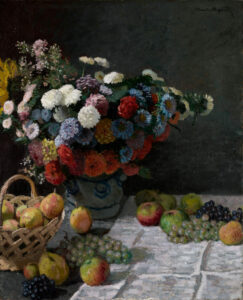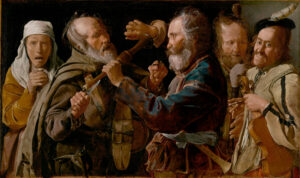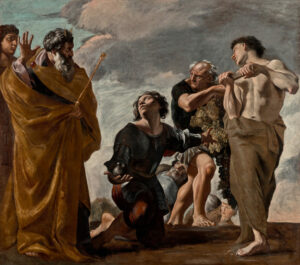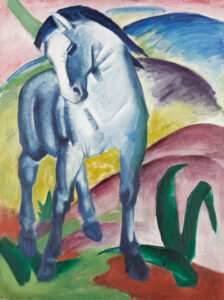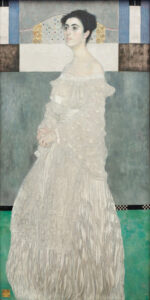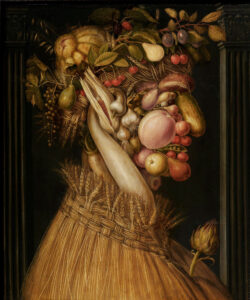
Vincent van Gogh, born March 30, 1853, in Groot-Zundert (Netherlands) and died July 29, 1890, in Auvers-sur-Oise (France), stands as one of the most iconic figures in art history. His colossal body of work, comprising over 2,000 paintings and drawings created primarily during the last decade of his life, bears witness to a meteoric artistic journey that revolutionized Western art. Initially naturalistic, influenced by Impressionism and Pointillism, his art heralded the Fauvism and Expressionism of the 20th century.
Van Gogh’s extensive correspondence, particularly with his brother Theo, provides invaluable insight into his creative process and artistic vision. This fraternal relationship, documented in 652 letters, represents the essential connection that enabled Vincent to pursue his artistic quest despite the personal and financial difficulties that marked his existence.
Biography of Vincent van Gogh
Origins and Formation (1853-1880)
Born into a family of the old Dutch bourgeoisie, Vincent van Gogh grew up in a household marked by the presence of his father, a Protestant minister. His childhood is described as serious and contemplative. Family influence was decisive, particularly that of his paternal uncles, several of whom were art dealers, including one associated with Goupil & Cie, where Vincent would begin his professional life.
In 1869, at the age of 16, he began his apprenticeship at Goupil & Cie in The Hague, a branch managed by his uncle Hein. This international art dealership allowed him to develop his knowledge of the artistic milieu. His career took him to London and then to Paris, but his refusal to regard art as mere merchandise led to his dismissal in 1876.
Van Gogh then turned to a spiritual and religious vocation, aspiring to become a minister like his father. After unsuccessful attempts at theological studies, he became a lay preacher in the Belgian Borinage in 1878. His commitment to the miners, whose precarious living conditions he shared, reflected his profound social compassion, but his mission was interrupted, deemed too radical by religious authorities.
Birth of an Artist (1880-1886)
In 1880, at the age of 27, Van Gogh decided to devote himself entirely to art. He enrolled at the Royal Academy of Fine Arts in Brussels on the advice of painter Willem Roelofs. From February 1881, his brother Theo, now manager of a Goupil & Cie branch in Paris, began providing financial support, a sustaining relationship that would last until the end of his life.
The following years were dedicated to learning drawing and painting, particularly in The Hague where he received lessons from his cousin Anton Mauve. His palette was then somber, influenced by the realist Barbizon school and the Dutch painters he admired. During this period, he created his first significant works, including “The Potato Eaters” (1885), an emblematic painting of his Dutch period that demonstrates his interest in peasant life and the social conditions of the underprivileged.
Parisian Period (1886-1888)
In February 1886, Van Gogh joined his brother Theo in Paris. This Parisian period constituted a decisive turning point in his artistic evolution. He discovered the Impressionists, met Paul Signac, Émile Bernard, Henri de Toulouse-Lautrec, and Paul Gauguin, and familiarized himself with Neo-Impressionism. His palette brightened considerably, adopting vivid colors and a more fragmented touch.
In Paris, he also became interested in Japanese prints, which he collected, and whose influence would be decisive in his conception of space and color. This intense period of training and experimentation allowed him to rapidly absorb the pictorial innovations of his time while progressively forging his personal style.
Provençal Period (1888-1890)
On February 20, 1888, Van Gogh settled in Arles, seeking the brilliant light of Provence. This extremely fertile period saw the birth of some of his most famous works: “The Bedroom,” “Sunflowers,” “The Night Café.” His palette exploded with vivid, contrasting colors, while his touch became more expressive.
Dreaming of creating an artists’ community in his “Yellow House,” he invited Paul Gauguin to join him in October 1888. Their cohabitation ended dramatically on December 23 with the tragically famous episode of the cut ear, a manifestation of mental instability that would worsen. Following this incident, Van Gogh was hospitalized in Arles.
Faced with pressure from Arles residents who considered him dangerous, Van Gogh voluntarily entered the asylum of Saint-Paul-de-Mausole in Saint-Rémy-de-Provence in May 1889. During this year of internment, interrupted by crises, he painted relentlessly, producing major works such as “The Starry Night,” characterized by swirling forms and increased emotional intensity.
Final Days in Auvers-sur-Oise (May-July 1890)
In May 1890, on Theo’s advice, Van Gogh left the asylum to settle in Auvers-sur-Oise, near Paris, where he was followed by Dr. Paul Gachet, a friend of the Impressionists. During the last 70 days of his life, he experienced a frenetic period of creation, producing nearly 80 paintings, including “The Church at Auvers,” “Wheatfield with Crows,” and “Tree Roots,” his final work.
On July 27, 1890, after painting “Tree Roots,” Van Gogh shot himself in the chest. He succumbed to his wounds two days later, on July 29, at the age of 37, with his brother Theo at his bedside. Theo, deeply affected by his brother’s death and himself suffering from syphilis, died six months later in January 1891.
Work and Artistic Style of Vincent van Gogh
Stylistic Evolution
Van Gogh’s artistic journey demonstrates a rapid evolution and an exceptional capacity for assimilating and transforming influences. Starting from a dark naturalism in his Dutch period, he adopted the lessons of Impressionism in Paris, to then develop a personal plastic language characterized by:
- Color – Van Gogh used pure, contrasting tints, often complementary, applied in thick, expressive strokes.
- Brushwork – His brushstroke progressively became more dynamic and structuring, conveying the emotional intensity of his vision.
- Composition – Influenced by Japanese prints, he simplified forms and adopted bold framings.
Principal Themes
Van Gogh’s work is characterized by several recurring thematic cycles:
- Self-portraits: Van Gogh created 37 self-portraits, testifying to his quest for identity and his technical explorations.
- Still lifes: The “Sunflowers” series constitutes the most famous example of his work with flowers.
- Landscapes: From Nuenen to Auvers-sur-Oise via Arles and Saint-Rémy, Van Gogh constantly reinterpreted the landscapes that surrounded him.
- Nocturnal scenes: The representation of night was a pictorial challenge that particularly inspired him, culminating in masterpieces such as “The Starry Night” or “Café Terrace at Night.”
- Portraits: Van Gogh endeavored to represent with empathy the people around him, from peasants to artist friends.
Pictorial Technique
Van Gogh often worked on canvases that were already prepared, which he could reuse by scraping off the previous work or covering it with a new layer. His technique of applying paint evolved toward a characteristic impasto, with visible brushstrokes that structure the composition.
His use of certain unstable pigments, such as geranium lake, which loses its red tint over time, has led to changes in the original appearance of his works, posing particular challenges for restorers. Recent studies have notably highlighted a chemical reaction affecting cadmium yellow in some of his paintings.
Correspondence and Intellectual Legacy
Van Gogh’s Letters
Van Gogh’s correspondence, primarily with his brother Theo, constitutes an exceptional document on his creative process and artistic thought. Of the 902 catalogued letters, 819 were written by him and 83 were addressed to him. Written in Dutch until 1886, then predominantly in French, these letters attest to his extensive artistic and literary culture, his reflections on art, and his profound aspirations.
These letters were not intended for publication but represent sincere introspection and valuable documentation on the artistic and intellectual context of his era. They also contain numerous preparatory sketches for his works.
Artistic Influences
Van Gogh drew upon varied artistic influences throughout his career:
- Dutch masters: Rembrandt and Frans Hals
- French realist painters: Jean-François Millet
- Colorists: Eugène Delacroix, Adolphe Monticelli
- Impressionists: Claude Monet, Edgar Degas
- Neo-Impressionists: Paul Signac
- Japanese prints by Hiroshige
- His contemporaries: Paul Gauguin, Émile Bernard
Posterity and Recognition
Posthumous Recognition
The recognition of Van Gogh as a major artist truly occurred only after his death. This phenomenon is largely due to the efforts of Johanna Bonger, Theo’s widow, who inherited almost all of Vincent’s works. With determination, she organized exhibitions, published his correspondence, and established contacts with influential galleries and collectors.
From the 1890s, a few critics and artists recognized the importance of his work. The 1901 Salon des Indépendants in Paris marked a turning point in his international recognition. Russian collectors Ivan Morozov and Sergei Shchukin were among the first major buyers of his works. The market value of his paintings increased rapidly, as evidenced by the purchase of “Sunflowers” by the National Gallery in London in 1924.
In 1930, the exhibition at the Museum of Modern Art in New York, which attracted 120,000 visitors, definitively established Van Gogh as one of the major artists in art history.
Influence on Modern Art
Van Gogh’s influence on 20th-century art is considerable. He is considered an essential precursor to several artistic movements:
- Expressionism: His emotional use of color and expressive brushstrokes directly inspired artists such as Ernst Ludwig Kirchner and Oskar Kokoschka.
- Fauvism: His brilliant and non-naturalistic palette influenced Henri Matisse, Maurice de Vlaminck, and André Derain.
- Symbolism: His conception of art as an expression of an inner reality presages certain aspects of symbolism.
The Van Gogh Myth
The figure of Van Gogh has generated a veritable myth in the collective imagination, that of the accursed artist, misunderstood in his lifetime, suffering from mental disorders and dying in misery. This romantic image, although partially founded, has sometimes obscured the reality of a cultivated artist, a hard worker fully conscious of his artistic approach.
Beyond this myth, it is indeed the intrinsic power of his work that ensures its permanence. As he himself wrote in his last letter: “Well, in truth we can only make our pictures speak.”
Conclusion
Vincent van Gogh embodies one of the most fascinating artistic trajectories in art history. In just ten years of creation, the last four of exceptional intensity, he developed a revolutionary pictorial language that transformed Western art.
His work, at the crossroads between tradition and modernity, constitutes an essential bridge between 19th-century Impressionism and 20th-century avant-gardes. The expressive power of his paintings, their chromatic intensity, and their emotional sincerity continue to deeply touch the public, making Van Gogh one of the most universally admired artists.
Beyond his artistic genius, it is perhaps this ability to communicate directly with the viewer, to convey an intensely personal vision of the world, that explains the lasting fascination exercised by his work. Van Gogh reminds us that authentic art is born of an absolute inner necessity and a total commitment of being.

